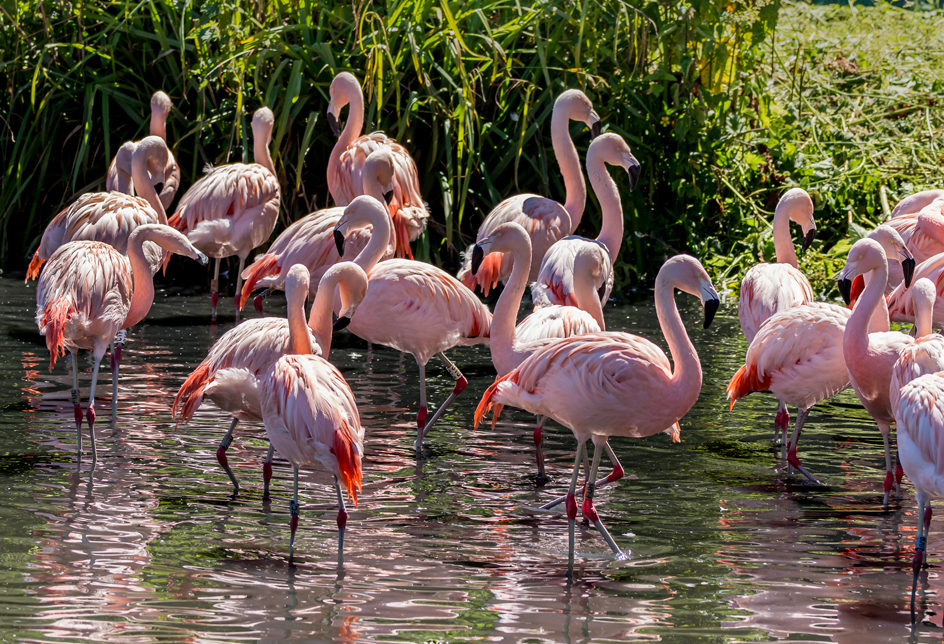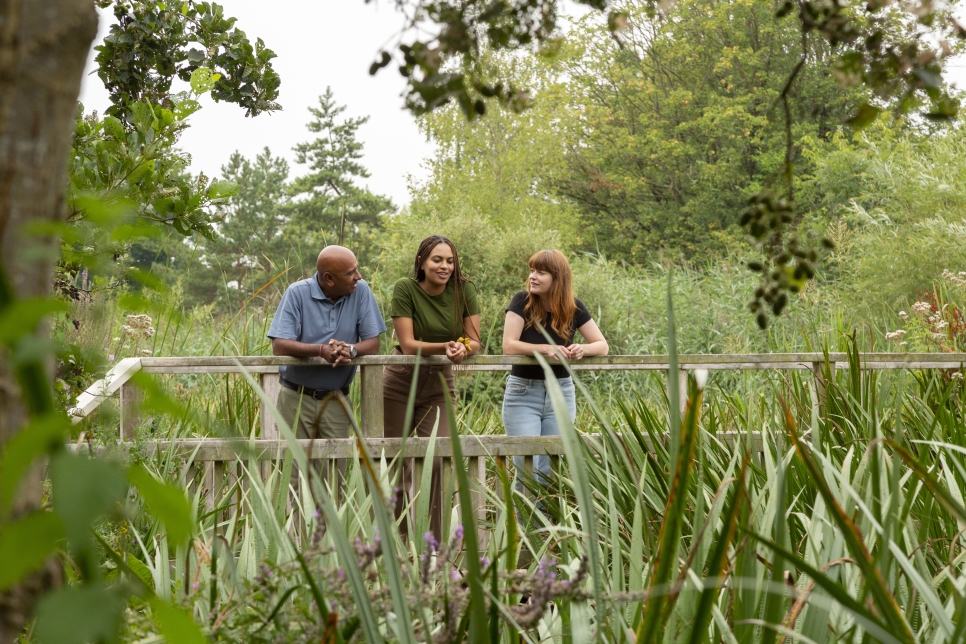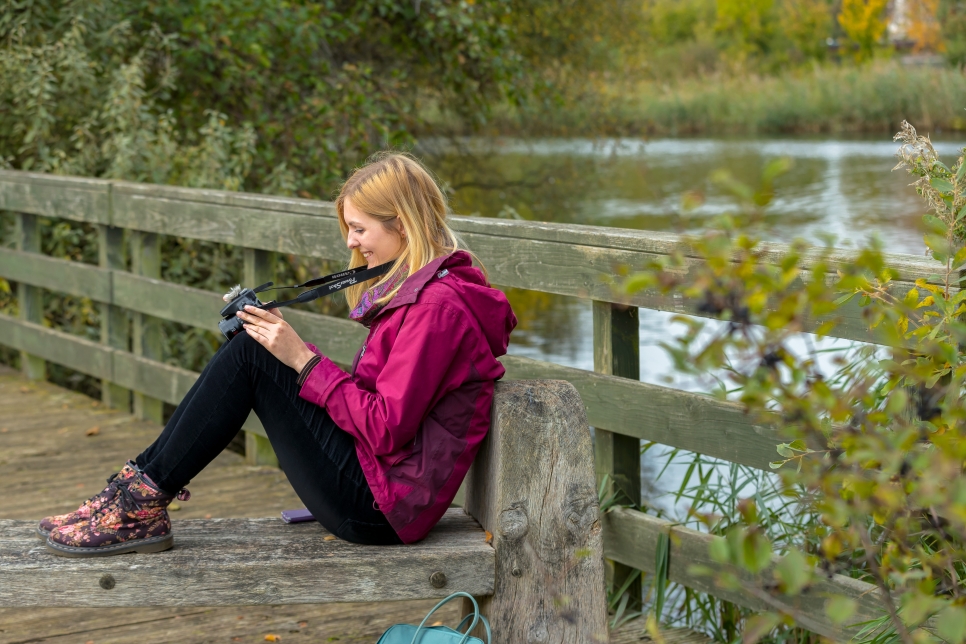Restore your mental wellbeing in our uplifting wetlands this autumn

Whether it’s a gently swaying reedbed, a calm meandering river, huge open skies above a glass-like lake or the seclusion of a small woodland pond, wetlands in all their forms offer us a ready distraction from our everyday lives.
Not only do they give us fresh air, peace, beauty and space; they also provide a deeper connection and an awareness that we’re part of something so much bigger than ourselves.
And with one in four people in England experiencing poor mental health each year*, there’s never been a more important time to get out and enjoy wetland nature.
This World Mental Health Day (10 October), discover how a visit to WWT Washington Wetland Centre - with its uplifting wetlands, full of inspiring wildlife – can help improve your sense of mental wellbeing.
“Man needs nature for his spiritual wellbeing, as well as his material wellbeing." Sir Peter Scott, founder of the Wildfowl and Wetlands Trust (WWT)

- Why wetlands?
The annual World Mental Health Day is a reminder to ourselves that, as our lives grow ever more hectic and fast-paced, it is vital that we prioritise our mental health just as much as our physical.
Spending time in nature - particularly near water - has real wellbeing benefits. It’s been proven to make us feel happier and reduce negative thoughts and levels of stress (YouGov research shows that 65% of people find being near water improves their mental wellbeing).
The People & Nature Survey for England 2020 also found that 85% of adults reported being in nature made them happy during the stresses and strains of the Covid pandemic.
This is why the Wildfowl & Wetlands Trust (WWT) is busy researching the impact our “blue” spaces have on our health and wellbeing, with findings so far including the fact that just ten minutes in a wetland setting can lead to an increase in positive feelings.
- Why visit in autumn?
To experience wetlands in autumn is to know them at their most restorative.
Just as they offer a two-way rest and refuelling point for migrating birds and sanctuary to thousands of animals as the colder weather creeps in, they also make the perfect place to slow down, relax and escape daily pressures.
Below, we’ve pulled together some examples of how immersing yourself in WWT Washington’s autumnal surroundings can contribute to improved mental health for everyone, no matter your age or interests.
Plus, give your wellbeing some virtual TLC by learning more about the deep connections humans have with wetlands here http://bit.ly/wetlandsandus
- Be inspired by birds
Autumn is all about awe-inspiring migratory journeys – large-scale nature on the move and at its most visceral.
If you really take the time to think about what these birds go through to make their perilous trips, you’ll experience one of those realisations that nature is so adept at delivering: the feeling that we’re part of something extraordinary.
Escape the everyday and take time out in our waterside hides to sit and soak in this spectacle – with highlights including black-tailed godwit, common snipe and whimbrel, as well as the occasional mute swan.
Read more about the kind of migratory species we’re seeing on Wader Lake right now.
Our woodlands are a hive of mindful activity too, with redwing and fieldfare feasting on berries, as tits and finches visit the feeding stations
At Hawthorn Wood Hide, colourful woodland birds flit among the shady tree branches, bringing movement and gentle twittering with them. Sit and absorb the goings on, as the low seasonal sunlight gently floods in through the floor-to-ceiling window.
This provides close-up views for wheelchair users or buggies too – you’re never too young to start your mindful birdwatching journey!
There’s also something mesmerising about the sound of a bird’s wings as it flies overhead – from the slow ‘whomp-whomp’ of a powerful mute swan to the skittish flurry of a wading bird or the loud arrival of whiffling geese. Pause on the footpaths near our water bodies. Can you hear any as they take off or come in to land?

- Explore through your senses
Our senses play an essential part in how we experience the natural world.
Most often, we interpret nature visually – watching a breath-taking sunrise or marvelling at a colourful butterfly, for example – but on a wander around our autumnal wetlands, your senses can be stimulated in other ways.
Stand, arms wide, at our reedbed on a rainy day and feel the heightened sensation of raindrops splashing your skin, or move under the nearby shelter to listen to the soothing rhythm of the drops falling, as you look across to Penshaw Monument and take in deep lungfuls of fresh, cool air.
Turn off the main path into nearby Hollowood and note the shift in light as the trees close in and stretch upwards around you, pushing bird sounds to the fore with twitters, chirrups and cries echoing overhead.
Practice being mindful and focus on your footsteps. Note the differing textures felt underfoot - from the squish of mulchy leaves to the crunch of pine cones. It might not be the best season for flowers, but there are other, more subtle, fragrances to be found. The leaves of an evergreen tree perhaps, or the smell of the earth after it has rained. This scent even has a special name: petrichor.
During autumn and winter, waterbirds gathering at the saline lagoon and Wader Lake make for a fantastic auditory experience, with their unique honks, whistles, squeaks and quacks. Listen to these select few and then see what you can identify on site the next time you visit https://bit.ly/winterbirdcalls
The ponds of our collection birds also have their own watery soundtrack, as they trickle and flow through the pens to join the River Wear. On sunny autumnal days, the light hits their surfaces at different angles, split by tree branches and late foliage, adding to the sense of movement as our ducks dabble and dive. Pause a while, relax and let yourself be mesmerised.

- Make connections
Spending time in autumnal wetlands is indeed balm for the soul. But it’s not just simply being in nature that can help improve our sense of wellbeing.
A recent key study by the University of Derby showed that connectedness – a real emotional relationship with nature that goes further than just exposure – matters more.
Evidence suggests there are five steps to wellbeing, defined by the NHS as:
- Connecting with other people, building an emotional support network and giving you the opportunity to share positive experiences outside the digital world
- Being physically active, developing self-worth through achieving goals and overcoming challenges and causing chemical changes in your brain to positively change your mood and raising self-esteem
- Learning new skills, such as gardening, birdwatching or art can generate a sense of purpose and satisfaction and possible 'flow' state
- Being generous, giving your time and effort to others and caring for the world we live ingenerates a feeling of reward and meaning
- Paying attention to the present moment and nothing but the present moment gives us relief from our racing minds. Some people call this awareness mindfulness.
Forging a more meaningful connection with nature isn’t about being able to name every bird you hear or plant you see, although this can also fit with the ways to wellbeing outlined above. Instead, the most important thing is being intentional as you interact with nature, and approaching it as an experience rather than simply a means to an end.
“It turns out that it is not just being in nature but how we open ourselves up and interact with nature that counts.” Mark Rowland, Mental Health Foundation Chief Executive
To help you explore just some of the ways that nature can help keep us healthy, WWT worked with our Blue Prescriptions partners the Mental Health Foundation to produce an Autumn and Winter Wellbeing Guide.
It’s full of ideas and activities you can do with others or by yourself, helping you engage with nature following the five steps to wellbeing and make the most of what wetlands have to offer during the colder months.

- Find your ‘sit spot’
Visiting the same area of our wetlands over and over again and sitting in quiet awareness might not seem the most exciting thing to do, but finding your ‘sit spot’ can help you gain a better understanding of the wild world around you; or at least one small part of it.
Seasonal changes, comings and goings of wildlife, the impact of the weather – all of these can be experienced more completely by repeatedly spending time in the same space, as often as possible.
Make sure your spot is safe and sheltered from the elements, get comfy, switch off your devices and be as silent as you can. Go through a checklist of your senses. What can you see, hear, smell or feel? Can you sketch what you’re experiencing or make notes to compare with future visits?
Aim to spend at least 15 minutes at a time in your spot. This gives you a chance to relax into your surroundings and start absorbing them. Then each time you return, note what is different. New species, new colours, new smells, new sounds?
This technique can be used when exploring any outdoor space and our wetlands are full of potential ‘spots’!
Find yours this autumn and you’ll be amazed by how much more you notice, experience and learn to appreciate the amazing nature that surrounds you.

- Capture nature’s beauty
What better way to boost your mood than appreciating the beauty of nature and creating art that celebrates it?
As part of our Drawn to Water: Quentin Blake at WWT experience, we’re running art workshops for people of all ages and abilities throughout the year. In autumn you can enjoy nature journalling, watercolour painting and clay animal making, with plans being finalised for our winter offer. Find out the latest details on our What’s On pages.
Autumn’s earthy palette and gentle light also lends our wetlands and their wildlife a magical glow – an ideal challenge for aspiring or established photographers to have a go at capturing. Read advice from our volunteer photographer Ian Henderson on where and when to get the best autumnal shots around our site.

- Nurture wetlands
One of the best ways to connect with nature is to look after it. Become a WWT member and you are becoming an important advocate for both wetlands and the amazing wildlife they support. Without this commitment, we’d simply not be able to do what we do.
Find out more about the incredible things your membership money helps us to achieve and how to join the WWT family here.
Ready to visit?
If you've been inspired to explore the award-winning Washington Wetland Centre and boost your own wellbeing this season, find out more and plan your visit online.
*Adult psychiatric morbidity in England, 2007: results of a household survey.



